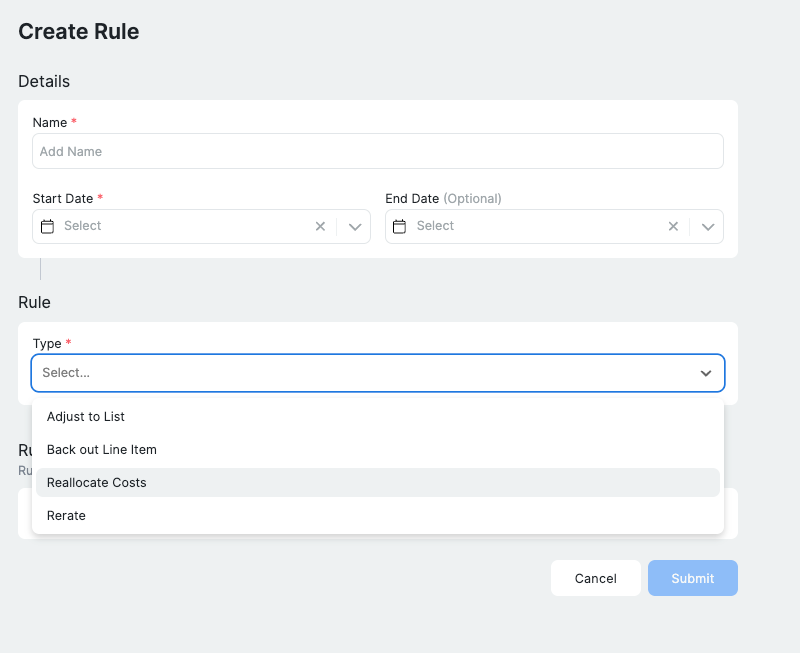Billing Rules Engine (f.k.a Cost Allocation)
Ternary Cost Allocation has been merged with the MSP Billing Rules Engine. Direct customers now have access to additional rule types. Cost Allocation is now a specific rule type called "Reallocate Costs".
Overview
Ternary's Billing Rules Engine enables users to create and manage cost billing rules to support accurate chargeback, showback, and cost redistribution strategies. Organizations often need to apply business logic to reshape raw cloud billing data so that each team, product, or project understands its true cost of ownership—inclusive of shared services, support fees, or compliance overhead. This helps drive accountability, unit economics awareness, and data-driven financial decisions.
Key capabilities
The Billing Rules Engine allows users to:
- Define multiple rule types to support varied allocation or cost transformation logic.
- Set start and end dates to restrict when a rule applies.
- Create one-time or recurring (daily) execution schedules.
- Filter source costs using labels such as project, team, or environment.
- Reallocate costs using static proportions or dynamic weighting.
Navigation
You can access this feature via:
Cost Assist → Billing Rules Engine
Creating a new billing rule
Click “Create Rule” to start building a new rule.

Rule details
| Field | Description |
|---|---|
| Name | A clear, descriptive name that summarizes the rule's purpose (e.g., Redistribute Shared GCP Support Fees) |
| Start Date | The date from which this rule should apply |
| End Date | Last date this rule should apply (leave blank for indefinite) |
Rule type
Use the Type dropdown to choose from one of the following rule types:
| Rule Type | Description |
|---|---|
| Adjust to List | Adjust cost values to match a predefined list of adjustments |
| Back out Line Item | Remove or reverse specific line items from the billing view |
| Reallocate Costs | Redistribute costs from a source group to one or more targets |
| Rerate | Apply a new rate to a set of cost line items (e.g., for internal transfer pricing) |
Each rule type triggers a different UI configuration below based on the selected option.
Rule-specific configuration for cost allocation
Depending on the rule type selected, additional configuration panels will appear. The following section is specific to Reallocate Costs, which is the most common rule type.
Cost Origin (reallocate costs only)
| Field | Description |
|---|---|
| Groupings | The dimension along which the cost will be grouped (e.g., Vendor, Service, Project ID) |
| Filters | Optional filters to scope which subset of cost is selected as the source |
| Inverse Entries | Every reallocation will auto-generate a negative line item for the source, preserving the original total cost footprint. |
Cost Destination
Dynamically Weighted - Allocate based on consumption metrics (e.g., share of Compute Engine cost)

| Field | Description |
|---|---|
| Measure | Basis for calculating dynamic shares (e.g., Cost, Usage Quantity) |
| Minimum Share (Optional) | Exclude targets that fall below a defined threshold |
| Weighting Keys | Dimensions like Project, Service, or Environment to distribute based on |
Statically Weighted - Allocate using fixed percentages (e.g., 70% to Team A, 30% to Team B)

Targets
For statically weighted rules: Explicitly define each target with its associated weight or percentage
Example: Project ID = 123 → 25% Project ID = 456 → 75%
For dynamically weighted rules: Targets are inferred from weighting key combinations. Reallocation will reflect the granularity of selected grouping and weighting keys.
Rule execution
| Mode | Description |
|---|---|
| One-Time | Manual execution once, often used for retroactive corrections |
| Scheduled | Runs daily and updates current and last closed invoice month |
Example use cases
- Charge shared services: Allocate central IT costs to business units.
- Back out failed discounts: Remove charges that shouldn't appear in reporting.
- Internal transfer pricing: Apply custom markup to costs using Rerate rules.
- Showback engineering usage: Redistribute infra cost based on product/service usage.
Additional notes
- Rule configurations are version-controlled and auditable.
- All changes are tenant-specific and reversible by deleting a rule.
Updated about 1 month ago
